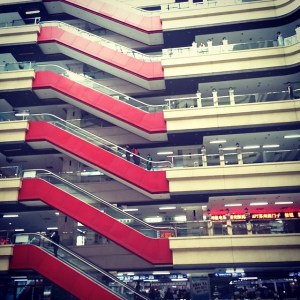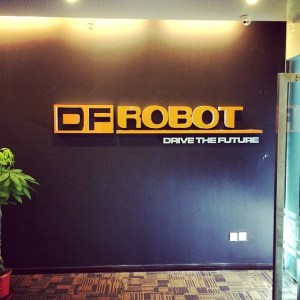We happened to be in Shanghai for Electronica trade fair this year and had a great time exploring heavy industrial gear and fantasizing about all the things we could do with it. However, we simply couldn’t ignore the fact that there was a whole city out there that we’re completely missing out on. So after less than a day of being surrounded by businesspeople and Miss Universe-dressed promoters, we decided to pack our bags and hit the streets.
The question was, where should we go? Finding interesting things in a city that keeps shapeshifting (the whole Shanghai skyline did not exist 20 years ago) can be a challenge. Fortunately, our friend [David Li] gave us a list:
- Xin Che Jian
- Jiu Xing market
- Beijing Lu electronic market
- Qiujiang Lu CNC/lasercut market
- DFRobot.com
…and off we were.
The Country’s First Hackerspace
 Xin Che Jian is China’s first hackerspace, founded in 2010 by [David Li] and is currently based in Downtown Shanghai, Xuhui district. [David] is being modest in saying that the reason behind founding Xin Che Jian was not changing the world, but rather a simple fact that his wife wanted to throw out all the hardware junk he’s been piling up in the apartment and he needed a place for it. The reality is that this place has completely transformed the ‘Maker’ scene in China (term “Hacker” is rarely used on the other side of the Great Firewall). Inspired by this example, people have started opening up spaces in different cities and the whole thing is starting to reach scary proportions with government stepping in, creating “makerspaces” in schools and providing TV coverage.
Xin Che Jian is China’s first hackerspace, founded in 2010 by [David Li] and is currently based in Downtown Shanghai, Xuhui district. [David] is being modest in saying that the reason behind founding Xin Che Jian was not changing the world, but rather a simple fact that his wife wanted to throw out all the hardware junk he’s been piling up in the apartment and he needed a place for it. The reality is that this place has completely transformed the ‘Maker’ scene in China (term “Hacker” is rarely used on the other side of the Great Firewall). Inspired by this example, people have started opening up spaces in different cities and the whole thing is starting to reach scary proportions with government stepping in, creating “makerspaces” in schools and providing TV coverage.
We happened to be there on a rainy Wednesday night, and the whole place had an irresistible Bladerunner feel to it. Walls of cardboard boxes, hydroponics tent, tons of electronics and all sorts of people ranging from local makers to expat “new media” artists. The night we visited was “open night” and we got to hear a lot of interesting and diverse talks. Talk topics had a very wide range. One discussed using Max/MSP to generate sound corresponding to the time lapse camera recordings of the space. Another slightly bizarre demonstration outlined the importance of insulation when dealing with high voltages, which among other things, included “spark frying” of something that moves.
Shopping for Electronics
Next stop was Beijing Lu electronics market. This one is a dream — a five-floor superstore exclusively selling electronics components. It’s a farmer’s market for silicon. We have learned that a lot of these shops are actually brick-and-mortar fronts for stores on TaoBao, but here you can buy things first hand, with a personal touch from “your guy”. If you happen to live in Shanghai, you can get components delivered the same day, pizza-style: by carrier on scooter.
Surrounding streets are even better. It’s where you can buy metal, plastic, get stuff cut, folded, CNC’d or spot-welded right on the curbside. Big blocks of steel, iron, aluminum all cut to order by artisans with decades of experience. For makers, artists and hackers this is where a lot of the real jewels lie. For an extra dystopian flavor, you can enjoy the fact that, among rows of such shops, you can find things like food stands, cleaners and grocery stores. You can get your aluminum cut in one shop and get your nails done nextdoor.
And now for something completely different..
Small Business Catering to Makers
DFRobot is something you would not ordinary expect in China. It’s offices look & feel like a proper Silicon Valley startup; it’s engineers are young, passionate and big on Open Hardware. They have great ideas and build beautifully designed products targeting the DIY community, educators and researchers. Their goal is “bringing back the joy of thinkering to daily life” – still a radical concept in China. If I were Adafruit or Sparkfun, I would watch out for these guys.
We got to hang around their office and saw a lot of great projects, but the experience we enjoyed most was in the 3D Printer room. We came into this room only to find a couple of dozen 3D printers, all printing bones! Some professor ordered a couple of hundred human bones for him to use in some kind of kinetic art installation. Weird.
For more in-depth look on Maker culture and it’s intersection with industry development in China, check out our attempt at serious investigative journalism in an interview with the fantastic [Silvia Lindtner], researcher at Fudan University.


























Can I get more information on the Qiujiang Lu CNC/lasercut market?
Where exactly is it located? Do you have any pictures of it?
Thanks for the help.
-failsafe
Awesome report!!! Thank you Hackaday that you put Shanghai in the focus. You are welcome anytime to visit us again.
BTW, your party in Abbey Road was a great experience too, so many people with the same interests in one pub…awesome!!!
I know there’s plenty of content out about it already, but I can never get enough video of the streetside electronics markets in shanghai and shenzhen/guangzhou. Get on it, HAD!
I would like to find someone who could build me a simple tdcs (Transcranial Direct Current Stimulation) device. I ‘ve seen one built on Youtube and it took 10 minutes. Anyone have any ideas would love to hear from you.